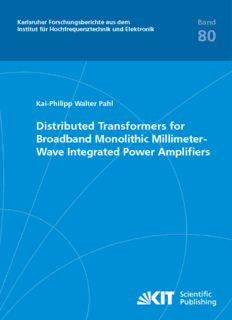
Distributed Transformers for Broadband Monolithic Millimeter-Wave Integrated Power Amplifiers PDF
Preview Distributed Transformers for Broadband Monolithic Millimeter-Wave Integrated Power Amplifiers
Karlsruher Forschungsberichte aus dem Band Institut für Hochfrequenztechnik und Elektronik 80 Kai-Philipp Walter Pahl Distributed Transformers for Broadband Monolithic Millimeter- c hi t oli Wave Integrated Power Amplifi ers ns oer Mfi d pli nm a bA dr ae ow Bro or d P fe s t ra er mg e ornt nsfe I av ra TW d - uteeter bm DistriMilli hl a P P. K.- Kai-Philipp Walter Pahl Distributed Transformers for Broadband Monolithic Millimeter-Wave Integrated Power Amplifiers Karlsruher Forschungsberichte aus dem Institut für Hochfrequenztechnik und Elektronik Herausgeber: Prof. Dr.-Ing. Thomas Zwick Band 80 Distributed Transformers for Broadband Monolithic Millimeter- Wave Integrated Power Amplifiers by Kai-Philipp Walter Pahl Dissertation, Karlsruher Institut für Technologie (KIT) Fakultät für Elektrotechnik und Informationstechnik, 2014 Impressum Karlsruher Institut für Technologie (KIT) KIT Scientific Publishing Straße am Forum 2 D-76131 Karlsruhe KIT Scientific Publishing is a registered trademark of Karlsruhe Institute of Technology. Reprint using the book cover is not allowed. www.ksp.kit.edu This document – excluding the cover – is licensed under the Creative Commons Attribution-Share Alike 3.0 DE License (CC BY-SA 3.0 DE): http://creativecommons.org/licenses/by-sa/3.0/de/ The cover page is licensed under the Creative Commons Attribution-No Derivatives 3.0 DE License (CC BY-ND 3.0 DE): http://creativecommons.org/licenses/by-nd/3.0/de/ Print on Demand 2015 ISSN 1868-4696 ISBN 978-3-7315-0409-2 DOI 10.5445/KSP/1000048002 Editor‘s Preface The enormous technological progress accomplished over the last decades facilitates the utilization of millimeter-wave frequencies for mass products like auto motive radar, industrial sensors, high-speed data communication links or medical applications. Besides novel and cost-efficient packaging technologies, in particular semiconductor technologies (e.g. SiGe, CMOS, GaAs, GaN, InP, etc.) with constantly improving cut-off frequencies are essential for the realization of cost- efficient and compact millimeter-wave modules. The dominant limita- tion factor of all semiconductor technologies is the available output power. The realization of faster semiconductor devices requires down scaling, which on the other hand results in a reduced breakdown voltage and finally less output power. While millimeter-wave ampli- fiers based on GaN achieve an output power of about 1 W at 100 GHz, above 200 GHz barely more than 100 mW have been achieved using InP technologies. Another issue is that amplifiers optimized for maximum output power usually only provide a limited bandwidth, which often is not sufficient for many communication, radar and also measurement applications. The key issue of having output power in conjunction with bandwidth is addressed in Mr. Kai-Philipp Walter Pahl’s thesis. To design an am- plifier that provides more output power than that of a single transistor device, multiple transistors are put in parallel. However, the maximum number of parallel devices that actually leads to an increased overall output power is limited, since the loss of the distribution network increases more than linearly with the number of transistors. The rea- sons for this are the increasing transmission lines lengths, which are necessary to separate the active devices and to provide the required impedance transformation. The higher the number of parallel transi- stors the higher the impedance ratio between the parallel transistors and the single common port of the amplifier. In addition a high trans- formation ratio results in a reduced bandwidth. One way to solve this issue is to use magnetic transformers for simultaneous power distribu- tion and impedance matching. A group around Hajimiri and Rutledge first proposed such an approach in 2001. In his dissertation Mr. Pahl has developed important scientific fundamentals for the development of monolithic integrated broadband amplifiers based on distributed transformers. By using a novel geometry of multiple distributed trans- formers, optimized for an application at millimeter-wave frequencies, he was able to demonstrate superior performance compared to the standard circular geometry known from literature. In particular the significantly improved design equations for efficiency optimized dis- tributed transformers, which are based on an improved equivalent circuit model, but also novel design equations for distributed transfor- mers with maximum symmetrical bandwidth, were a huge contributi- on to the scientific field and extended the state of the art significantly. I am absolutely sure that this work will attract much interest from the research community worldwide with many circuit realizations based on. My personal wish for Mr. Pahl is that his creativity and great inno- vative capacity will continue to earn him both scientific and economic success. Prof. Dr.-Ing. Thomas Zwick – Director of the IHE –
Description: